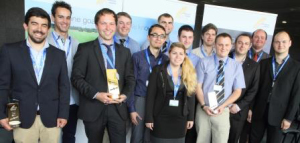The world’s population is expected to grow from almost 7 billion today to over 9 billion by 2050. In order to feed this population, the United Nations says farmers must produce 70 percent more food than they are today.
“To meet this future demand the world’s farmers must increase their agricultural productivity,” said Christian Radons of farm machinery manufacturer CLAAS. “This demand can only be met if we embrace new technologies such as satellite powered precision farming.”
Precision agriculture is a highly effective farming strategy that increases yield and lowers costs. It allows a farmer to optimise the use of their field by requiring less input (fertiliser, pesticides, seeds, fuel and labour). These savings can be reinvested into new equipment, which further optimises their operations for lower costs, increased yield and higher returns.
For Tamme van der Wal of AeroVision BV, the role of European GNSS systems (Galileo and EGNOS) in agriculture is simple: it decreases costs, increases yield and puts more money into farmers’ pockets.
All these ideas where put in place during the agriculture session at the European Space Solutions conference in Prague between 11-13 June. To emphasise the essential role of innovation in the future of farming, the session ended by announcing the winners of the 2014 Farming by Satellite Prize. This prize, an initiative of the European GNSS Agency (GSA) and first run in 2012, aims to promote the use and innovation of satellite navigation in agriculture by young people.
The first prize was awarded to German Daniel Hege of Geisenheim University. His winning project used satellite-guided steering during cultivation of mixed vegetables to both increase productivity by reducing planting gaps, and reduce time spent in the field by increasing speed of accurate weed control. He estimates his system can reduce total processing costs by up to 60 percent.
The second prize went to a UK team from Harper Adams University for their development of an autonomous precision robot that uses GNSS technology to help plant seeds in wet terrain.
The third prize was awarded to Manuel Penteado, a Portuguese entrant from the Instituto Superior de Agronomia. His project provided selective harvesting in olive and cork plantations via the use of remote sensing management.
The special Africa prize was given to Rwanda’s Faith Mwiza, whose project utilises drones for enhanced agricultural development.
“The standard of entries was even better than last year,” said Dr Andrew Speedy, chair of the judges. “Contestants showed good knowledge of the technologies and possibilities of satellite applications in agriculture.
This year 96 registrants, of which 43 were eligible, were received from eleven European and eight African countries. The entrants competed for a first prize of €5,000 with a day’s business mentoring, second and third prizes of €3,000 and €1,000 respectively for European teams, plus a €4,000 special Africa prize. In evaluating the entries, judges looked at relevance, feasibility, innovation and potential market.


